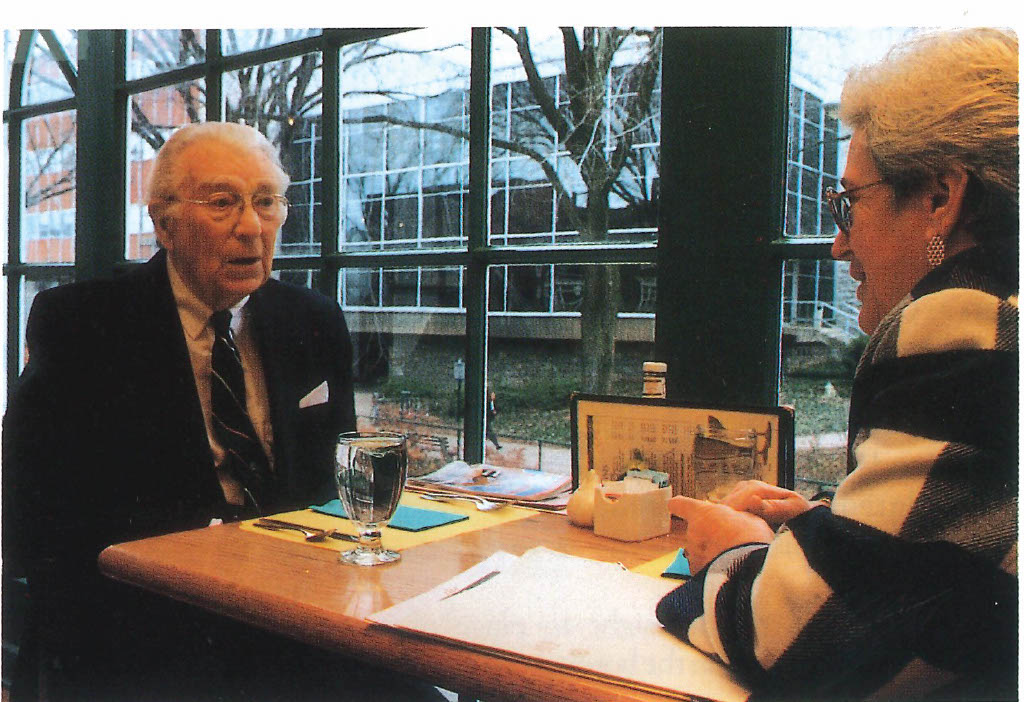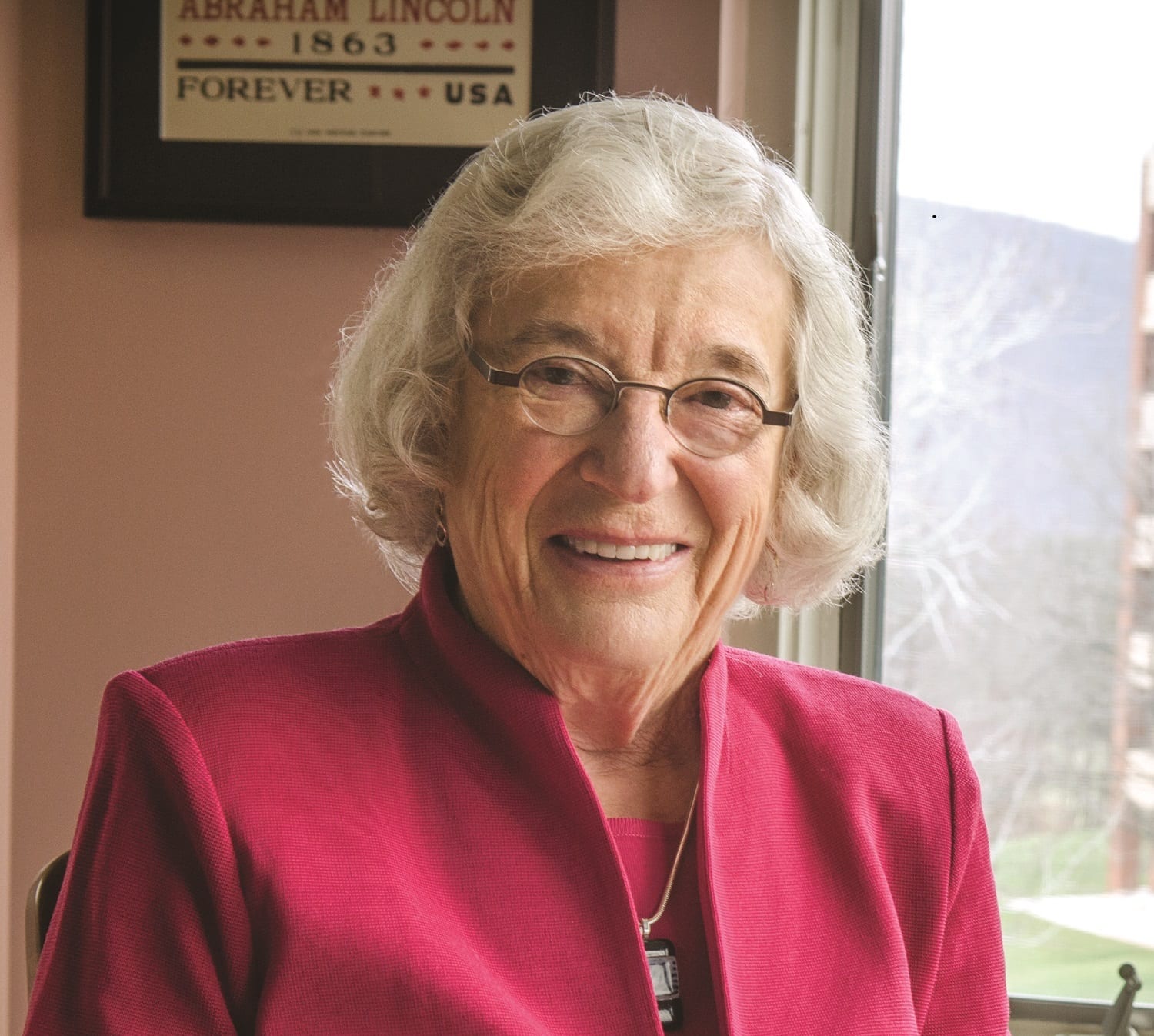Edited by Vilma Shu
Mimi is taking a summer break, so we’re reprinting the first Lunch with Mimi, originally published in January 1996.
In Town&Gown’s early years, Mimi Ungar Barash’s “Catalyst” column was an important feature of the fledgling magazine. It offered opinions—some controversial—on serious topics of the day. Beginning with the thirtieth-anniversary issue in 1996, T&G’s publisher again took out her notebook and pen in “Lunch with Mimi,” a question-and-answer session with a notable person from town or campus.
In that first Q&A, she chatted with Arnold Addison, who hadserved on State College Borough Council from 1960 to 1978 and then as mayor from 1978 to 1994. (Addison passed away in June 2000.) During that Lunch, the pair discussed his time as mayor, downtown student housing, the borough’s then-upcoming centennial celebration in 1996, and the idea of consolidation with neighboring townships.

Mimi: What would you consider the most significant decision you made as a borough councilman?
Arnold: I introduced job classification/evaluation in the 1960s. When Act III was state law, I negotiated contracts with the police department. I led the effort to improve standards for the selection and retention of police officers, and I worked for a more professional level of officers to meet the needs of a progressive community.
Mimi: It seems to me that you’re the borough leader who was responsible for opening better communication between the borough and the university.
Arnold: I believe this was an important effort, successfully completed while I was mayor. Involved in this advancement was the increased rate of elected officials in deliberations on mutual problems influencing town-gown relations. David Schuckers, special assistant to the president for government affairs, co-chaired the president’s advisory committee on community relations. The final report provided a blueprint for action for people on both sides of College Avenue.
Mimi: T&G started in January 1966. You were on Borough Council at the time and may recall that the trustees decided not to build any more student housing on campus. Can you reflect on the transition relative to high-rise construction downtown?
Arnold: We had much development on Waupelani [Drive]. The people downtown, the planning commission, and others got excited about that, saying that developers were taking prime land. I think at that time there was still a reluctance to accept the fact that one of our major businesses in the community was housing. And at that time, the planning commission said we must bring these developers downtown and we ought to have some incentive for them to do that.
The incentive was that they didn’t need to provide parking. I was opposed to that because I thought it was not facing the fact that even though students were going into these places, they were as married to cars as the rest of us were. However, we did have building downtown, and while people talk about the canyon on Beaver Avenue, I have never thought of it that way. I recall what was there before, and I just didn’t get excited about those old dilapidated houses because they weren’t maintained as historic places.
Mimi: You had the foresight to place major community emphasis on the borough’s centennial celebration.
Arnold: This has been an interesting, though at times a frustrating, experience for me. Since 1990, the commission I chair has been meeting monthly and working on programs in between. I believe we are in good shape. Recently I invited our elected officials at federal, state, county, and local levels to attend our events—most especially the community weekend featuring a traditional Alpha parade. Our executive director, Lurene Frantz, has been a community asset on this adventure.
Mimi: State College has experienced tremendous growth in its first century. What do you think the town will be like when it celebrates its bicentennial [in 2096]?
Arnold: Well, obviously it will be a larger population center. There is going to be further growth in outlying districts because there is very little in town on which to grow. I would see that we have more technology involved in the industry within and out of our community. It will be interesting to watch what the university does with regard to using the [branch] campuses to put some students there. As a borough, we just can’t accommodate many more. Careful attention in planning will be the focus of the effort in local government. Regional planning will require tremendous [Centre Region Council of Governments] effort.
Mimi: That leads me to my next question—consolidation. Good? Bad? What’s in store?
Arnold: From a standpoint of broadening the tax base, there are very few places where we can build. We’re dependent heavily on the wage tax. The student population pays property tax in rent, but they don’t work, so they don’t pay the wage tax. I’m not being critical about that. This simply means if we have continuation of student housing, and we’re likely to, then we’ll get a little more property tax, but not much. Nothing probably in wage tax.
Mimi: How do you feel about consolidation? Is it a possible solution?
Arnold: It’s a possible solution, but I don’t see it happening in my lifetime. For the sake of the borough, I would say we need consolidation. I can understand why the townships don’t want it at this time because right now they have so much land to develop.
Mimi: Do you want to make any comments about Town&Gown?
Arnold: I think it’s the best magazine in the area, in all forms.
Mimi: What should we change, in your opinion?Arnold: I don’t think you need to change anything. There’s so much about people, and I love to read about them. I’m interested in what they do. The magazine really is an ongoing history of our people and community. T&G




